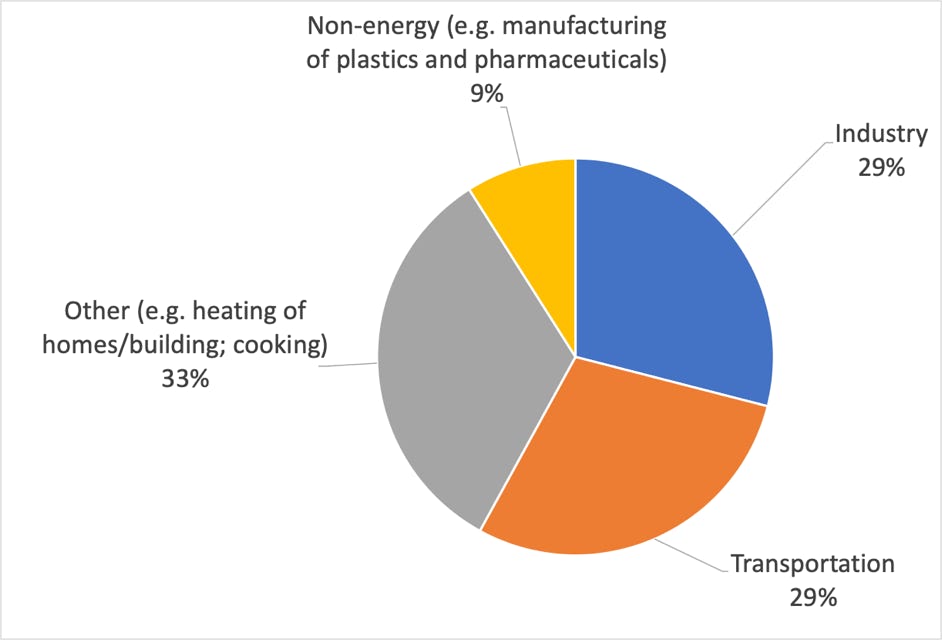What the heck is decarbonization?
Climate change is upon us. This year’s hurricanes and wildfires in California are only the latest signs. An integral part of dealing with climate change is the removal of carbon dioxide (CO2) from further energy production and excess existing CO2 in our environment. The path associated with this removal is what is referred to as decarbonization. The path is anything but steady and linear. It will continue to be full of starts, stops, and swerves. It will continue to be full of debates, arguments, and egos.
The current energy mix
Our current energy mix is complex with different energy sources and end uses. An overarching view is presented in what is known as a Sankey diagram which provides a visualization of energy flows. Flows are represented by bands whose width show their magnitudes. The wider the band, the larger the flow. Bands are combined or split through their paths at each process stage. Color is used to categorize the flows with energy transitions being an example.
Here is a Sankey diagram of the world’s energy mix for 2018 as presented by the International Energy Agency (IEA):
Along the left vertical are the energy sources. Along the right vertical are the end uses. The horizontal top and bottom show other energy dispositions other than end use. As noted earlier, the widths indicate magnitude and the merging of paths shows how end uses combine energy sources. The web version of the diagram is interactive providing detail information along each of the paths along with ways of seeing a Sankey for individual countries and how changes occur over years of time.
In 2018, the world got its energy from the following sources:
The energy from these sources were used by:
What is wrong with our current energy mix?
Quite simply, we get too much of our energy from sources that generate CO2 (aka burning of fossil fuels) that is throwing off our carbon life cycle, which in turn is the driving factor behind our changing climate. Decarbonization shrinks the width of the oil, coal, and gas arrows and increases the width of the non-CO2 generating sources.
What needs to be done to get to where we need to be?
There are a number of very smart people who can provide their different opinions on the best approach. And with all these opinions, there is a common pool of components that must be taken into consideration.
- Technology: We need the tools that technology offers to decarbonize. Fortunately, we have them today. Everything from solar panels to battery storage to electrical grid technologies, and beyond. With time, additional technologies will be produced and those we have now will only get better.
- Political: Climate change is a global issue that knows no national boundaries. Technology offers the opportunity. Politics offers the means with government policies and agreements leading the way.
- Regulatory: From policies comes the needed laws and regulations for definition, compliance, and enforcement.
- Environmental: As we look to massively scale non-fossil fuel energy systems, we must understand the impact each has on our environment. For example, what is the environmental cost associated with the acreage needed to host the required solar farms?
- Economics: Efforts to combat climate change will only occur if it is economically feasible.
- Culture: Perhaps the most difficult component of climate change is the changing of people’s behaviors. Humans are creatures of habit. Generally speaking, we do not adapt well or quickly to new circumstances. We expect circumstances to adapt to our behaviors. Climate change will challenge us to rethink how we work, how we travel, how we grow food, where we live, and so much more.
Where to from here?
Decarbonization is an extremely complex goal to achieve. The magnitude of the solve, the number of different components, the diverse stakeholder population, and the number of inter-component dependencies are only a few of reasons why. As a result, the decarbonization path will come not from a single plan agreed upon by all. Rather, it will come from disparate actions from the various facets that will make mistakes along the way, course adjust from within each component, and accommodate other components when faced with the critical need to integrate with other components. For example, the government will establish goals and policies independent of the needed regulations. Technology will be developed independent of the political and economic implications. Economic models will be produced regardless of whether society exhibits the needed cultural behavior changes to support the model.
The decarbonization journey is going to be a crazy ride. I for one, am confident we will get there - and when we need to get there.

